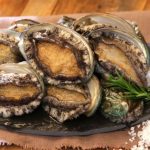 Although pronounced the same, abalone and a baloney—as in “a baloney sandwich”—are completely different foods: far from being a congealed paste of ground-up livestock, an abalone is an edible mollusc found off the coast of California. English borrowed the name of this mollusc in the mid nineteenth century from Spanish Americans, who in turn had previously taken the word from the Monterey Indian language. The scientific name for this mollusc is Haliotis, a Greek compound meaning sea-ear, so named because the abalone shell is shaped like the human ear; ear-shell, in fact, is a common, alternative name for the abalone.
Although pronounced the same, abalone and a baloney—as in “a baloney sandwich”—are completely different foods: far from being a congealed paste of ground-up livestock, an abalone is an edible mollusc found off the coast of California. English borrowed the name of this mollusc in the mid nineteenth century from Spanish Americans, who in turn had previously taken the word from the Monterey Indian language. The scientific name for this mollusc is Haliotis, a Greek compound meaning sea-ear, so named because the abalone shell is shaped like the human ear; ear-shell, in fact, is a common, alternative name for the abalone.
In the aquatic regions of California, there exists a prodigious, univalve mollusk. This specimen is often prepared as a savory steak, delectable chowder, and other gourmet dishes. However, the demand for this delectable creature has reached such heights that obtaining it fresh outside of the region is a daunting task. In order to utilize the abalone as a steak, one must first subject it to the tenderizing process.
The given passage pertains to a type of edible mollusk, which is commonly known by the names of sea ear and ear shell. This mollusk is highly favored as a food item in California, however, its export in any form is prohibited as a measure of conservation. The flesh of this mollusk is characterized by its toughness and must be beaten before consumption. It is important to note that the cooking time for abalone is minimal, as overcooking toughens the meat. Abalone is also considered a delicacy in China, where it is used in a dried form, and in Japan, where it is highly prized by gastronomes. Moreover, the iridescent shell of the abalone is a source of mother-of-pearl and was highly valued by the American Indians of the Pacific coast.
